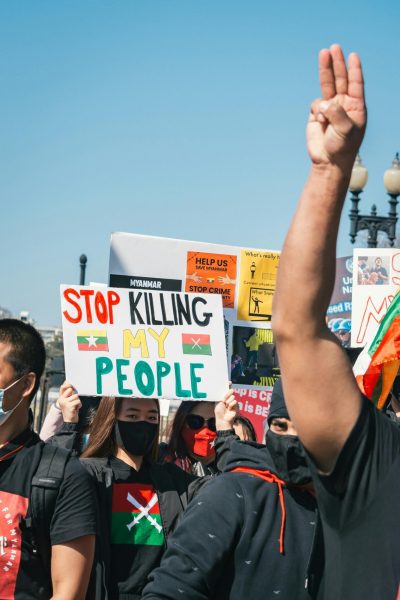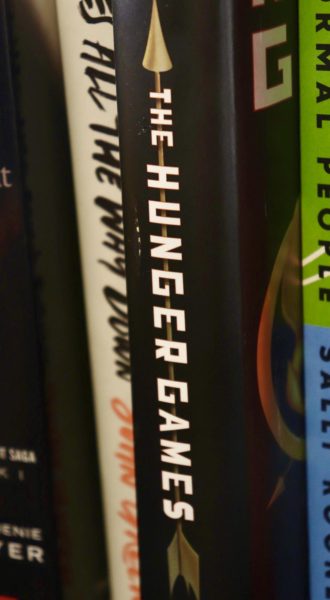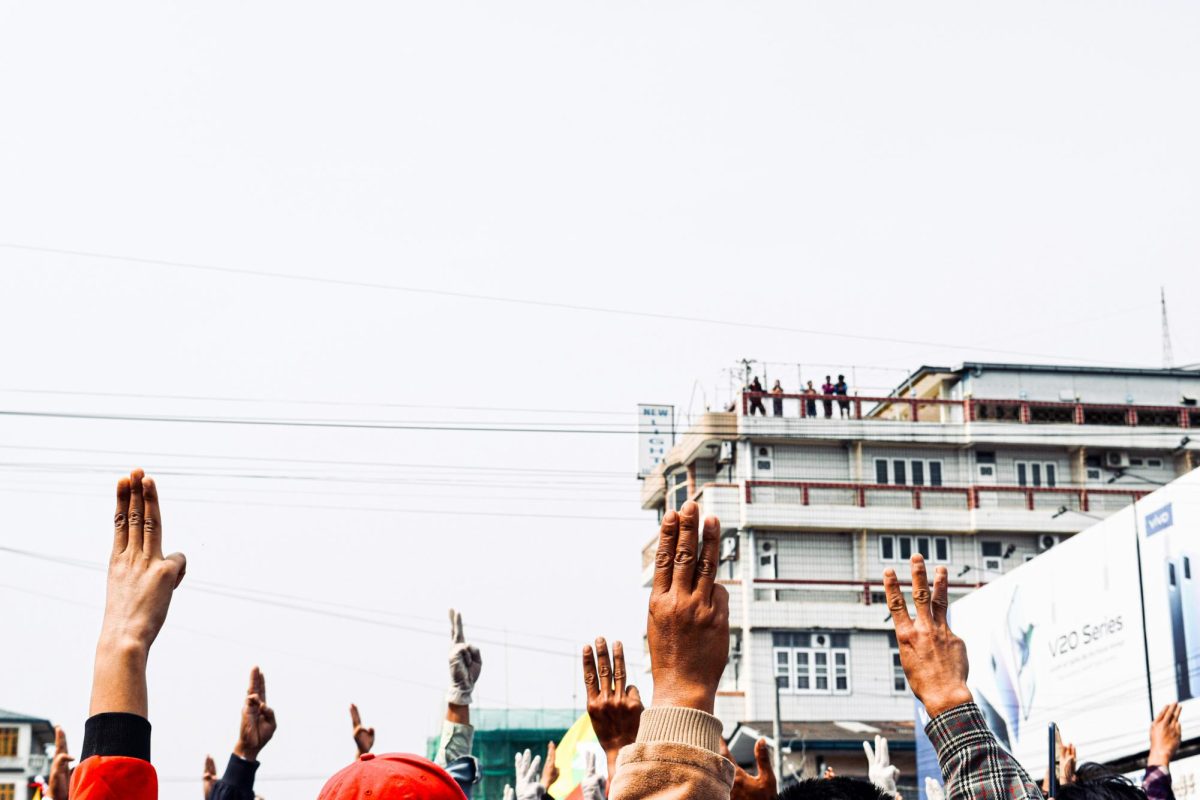The city is destroyed while war wages on. Crumbling buildings and a smoke-filled sky plague the area in the wake of destruction. In the desolate landscape, however, emerges a voice.
“I want to tell the rebels that I am alive…where the Capitol has just bombed a hospital full of unarmed men, women, and children. President Snow says he’s sending a message. Well, I have one for him. You can torture us, bomb us, and burn our districts to the ground. But do you see that? Fire is catching, and if we burn, you burn with us.”
While this scene may feel like something ripped from the news headlines today, in fact, these words were uttered by none other than the famous Katniss Everdeen amid war in Mockingjay, the third book of The Hunger Games Trilogy.
The Hunger Games was published in 2008 by author Suzanne Collins and first introduced readers to the world of Panem, a futuristic America. Many may know The Hunger Games as a young-adult dystopian franchise — what lies underneath, however, is a multifaceted political commentary on the fabric of American politics. “I don’t write about adolescents. I write about war for adolescents,” said Collins in an interview with the U.S. Schools Libraries Journal.
Each district is occupied by a different industry; in particular, Katniss’s home of District 12 experiences the toils and grunt of the mining sector. Beyond the wear and tear of daily life in the Districts is the macabre reality of the Hunger Games. The annual event pits two adolescents, ages 12-18, from each of the twelve districts and throws them into an arena. The chosen 24 subsequently experience the test of survival until one victor arises.
Why does this exist? Is it for the Capitol’s entertainment, protected by their place in the social hierarchy? Or, is it to punish the Districts? While a case could be made for all of the above, the torture of the Hunger Games is undeniable. This annual ritual becomes a pillar of suffering, where the hopes and dreams of the tributes are crushed beneath the Capitol’s relentless desire for control and dominance. The Hunger Games, as an entity, becomes a manifestation of the Capitol’s authoritarian grip, showcasing the lengths to which power will go to assert itself, even at the expense of the young and innocent.
The ongoing conflict between the Capitol, the wealthy class, and the Districts, the working class, infuses the series with parallels to our modern-day obstacles — the primary struggle of the Capitol for authority and the Districts for freedom lays the tapestry of a capitalistic and oppressive society.
As we navigate the current turbulent political landscape, the reflections of power, control, and oppression depicted in The Hunger Games offer a chilling echo of reality. The story acts as a mirror, forcing readers to confront the ethical implications of authority and the consequences of societal divisions. The events within the series and its prequel, The Ballad of Songbirds and Snakes, draw eerie parallels to the challenges we face today, prompting us to question the ethics of control in our own societies.
The Hunger Games Trilogy
When it comes to reinforcing the systems of capitalistic greed and the threat of imperialism, the looming presence of the Capitol embodies the hierarchy perfectly against the food-starved districts.
President Snow is a crucial figure in piecing together this application of The Hunger Games. In the original trilogy, he is the long-time President of all of Panem. “Snow’s evil shows up in the form of the complacently confident threat that’s ever-present in his eyes — his resolute stillness,” said Donald Sutherland, who played Snow in the franchise, in a letter to Director Gary Ross. His control of the Games and the Districts under an iron fist greatly compares to tyranny today.
While not a mirror of his character, actor Donald Sutherland was passionate about the message of the series. “Power perpetrates war and oppression to maintain itself until it finally topples over with the bureaucratic weight of itself and sinks into the pages of history,” Sutherland wrote in his letter.
These parallels of corruption seem stark, yet the equally charged reaction of Katniss Everdeen is not necessarily overly idealistic for us today. Katniss Everdeen, the trilogy’s iconic protagonist, emerges as a symbol of defiance against the corruption of the Capitol. Her journey from a marginalized resident of District 12 to the face of rebellion exemplifies the power of individual resistance against a system that perpetuates oppression, embodying a subversion to the social hierarchy.
She stands up to the Gamemakers during the Games by shooting at their apple; she mourns the young Rue from District 11, fellow tribute and her fallen ally, choosing humanity over the Capitol’s desire to quell war by separating the districts; she’s the “girl on fire” who takes a public stand against oppression, and she rises to the occasion as a rebel.
At her core, she fights for her family and for the cause she believes in. Katniss weaponizes her symbol of the Mockingjay and the well-known three-finger salute to advance her agenda.
The relevance of her fight is apparent in similar struggles today. The people of Myanmar, for instance, use the salute to advance their cause of civil disobedience against the ongoing military coup. This Southeastern democracy movement underscores the influence and effectiveness of displaying rebellion in literature. The resonance of these symbols, born out of a dystopian narrative, reflects the universal aspirations for freedom and resistance against oppressive regimes, emphasizing how the fictional struggles of characters like Katniss continue to inspire real-world movements for justice and democracy.

In the world of Panem at large, much like the intricate dance between colonial powers and African nations in Françafrique, where economic exploitation and political maneuvering persist, the Capitol’s domination over those who defy it serves as a haunting parallel, underscoring the perpetual struggles of the underprivileged.
Hegemons and inequality are often left poorly regulated and disproportionately impact these marginalized communities.
Alternatively, in the post-COVID-19 era, the tattered fabric of capitalism reveals its vulnerabilities, further corroded by corruption. The pandemic, acting as a societal litmus test, has exposed the deep-seated inequities within the system, with marginalized communities bearing the largest weight crisis. The existence of the Hunger Games, solely for the District children, illustrates a strikingly similar expendable target of the underprivileged, with over a thousand District lives lost throughout decades of the Games.
The Capitol’s economic exploitation of the districts mirrors the unchecked greed and moral erosion inherent in our capitalist structures, revealing a grim reflection of our own societal shortcomings. Katniss’s stylist Cinna’s gruesome demise in Catching Fire, the second installment from the trilogy, illustrates the expendable nature of even those not in the Districts.
It’s the Quarter Quell, and past victors return to the arena. But before their harrowing battle, the returning tributes must get an interview. Against President Snow’s wish for Katniss to wear her wedding dress, Katniss overpowers docility and instead returns in true rebellious fashion with a Mockingjay dress designed by Cinna, continuing the symbol of the Mockingjay. It’s this symbol that asserts rebellion and this symbol that lands Cinna a death in the hands of the Capitol. It’s the Mockingjay pursuit that threads oppression of those who stand out into the backbone of the Panem society.
Alongside Katniss’s hero’s journey is her diligent, kind-hearted companion Peeta Mellark. Reaped beside her for the 74th Hunger Games, Peeta symbolizes humanity in the series.
His mellow, yet equally important, steadfast heart contrasts Katniss’s spontaneity and fight. He is the empathy to the series, and his role as a symbol of hope is demonstrated through acts of self-sacrifice and calculated rebellion.
That all came to a screeching halt in Mockingjay, when the Capitol captures Peeta, effectively capturing hope. The abrupt thwarting of Peeta’s agency marks a turning point, emphasizing the Capitol’s ruthless grasp not just on individuals but also on the very essence of optimism. In this tragic crossroad, the series confronts the harsh realities of power, illustrating how the capture of one symbol can echo across the entire socio-political spectrum, leaving a void in the struggle for a better future.
Nonetheless, he refused to be manipulated and refused to betray his spirit.
Peeta’s character, like Katniss’s, contributes to the overarching message of resistance with the depth of not necessarily a fearless leader but a true moral compass. He urges readers to question authority and champion empathy in the face of systemic cruelty. “I think the characters are really well-crafted. The series is super nostalgic for me, but looking back, it’s very clear why it’s still so popular,” said Lucy Spooner ’25. “Aside from the interesting plots, people find connection and hope in these characters.”

The Ballad of Songbirds and Snakes
It’s impossible to articulate the impact of The Hunger Games without mentioning the newest addition to the universe. The Ballad of Songbirds and Snakes was published in May 2020, and a subsequent film adaptation was released in November 2023.
The prequel does what the Katniss-centric perspective makes impossible to articulate: the corruption of a dictator. The book and film follow the rise of eighteen-year-old Coriolanus Snow, a mere student at the Academy, before he became Panem’s President.
Through the exploration of President Snow’s origin story, set sixty-four years before the original trilogy, the narrative digs deep into the ethics of control within a corrupt, post-war society, drawing striking parallels to contemporary political and social structures.
Unlike Katniss’s hero’s journey as the face of a rebellion, Snow’s rise mirrors that of a dictatorship. A notable section arises from Snow’s early contemplation of power. Dr. Volumnia Gaul, Head Gamemaker of the Hunger Games, challenged Snow to write about the consequences of a country where the Capitol did not rule the Districts. His response? Chaos. Control. Contract.
While not at the height of his villainous powers, Snow’s motives throughout his story are rooted in this obsession with these three qualities, primarily craving not warmth and affection, but status.
Keeping the Snow family name reputable and keeping his name on top — unlike Katniss characterized by her fiery impulse, Snow’s methodical descent into his obsessions constantly marks his decisions.
When forced into the arena, Snow ends up killing a young Bobbin in self-defense. What stands out to be is the diverging reactions from page to screen. Collin’s writing keeps Snow’s purity, tangling him in his own guilt and loath to tell anyone of his wrongdoing. However, the film reduces this guilt into a different reflection, power. This slight difference develops Snow’s character interestingly, devolving his path to corruption and greed.
His signature catchphrase, ‘Snow lands on top,’ even corrupts itself. The affirmation transforms from a reinforcement of his hope to stay above water to a destructive, threatening utterance.
When Dr. Gaul, the Head Gamemaker, asks the question “What are the Hunger Games for?” the corruption grows as Snow’s answer shifts.
At first, he believed it to be a mere punishment for the districts.
In the end, he equates the Hunger Games to life itself — an existence that thrives off the suffering of others and results in a victor. The phrase ‘Snow lands on top’ takes on its new meaning. “The Capitol wants to be better than everyone else — they want to keep a power dynamic where they are superior. When they’re at the top, they view everything else as a game as long as their status [remains] unchanged,” said Chau Thai ’25. “Making The Hunger Games is the primary example of their unrestricted greed.”
By the end of The Ballad of Songbirds and Snakes, Snow’s kills total to four; while Bobbin’s demise could be justified by self-defense, the other three reveal Snow’s depraved pursuit of power. In particular, Snow poisons Casca Highbottom, Dean of the Academy, in an attempt to quell the voices of his opponents.
He poses this shift in the hierarchy — Highbottom’s dislike of his former student previously did not overshadow his status as an esteemed figure, yet in his murder, Highbottom becomes the victim of his former student’s wrath. Ultimately, Snow reverses the roles of authority and cements a cold-blooded methodology of instilling obedience through the permanent silence of death.
Sound familiar? Snow’s rise echos totalitarian beliefs, mirroring the tyrannical figures of the twentieth century. While his actualized villain role in the original trilogy mirrors that of a fascist dictator, his plight is not only an allegory of the past’s destruction. Rather, Snow reflects the inherent corruption of human nature, allured by the appetite for domination.
The Ballad of Songbirds and Snakes as a reflective tale of the present interweaves the corruption of an ambitious hopeful with the rise of a post-war dictatorship. I believe that actor Donald Sutherland said it best: “He was… a brilliant man who’s succumbed to the siren song of power.”
One aspect of the sequel as a whole that I admire most is Collins’ established desire to send this message, recontextualizing her universe to help us audience members understand ours more as well. It’s not a cash-grab just to profit off another large franchise, but rather a profound commentary on the potential society can build without proper intervention.
The Hunger Games and its sequel function in tandem with each other. While one centers on the potential of a reactive force to combat the wrongs of the world, the other seeks to identify the seeds of control that seep into the primarily villain-like figures in our present.
The novel’s dystopian narrative serves as a cautionary tale, urging readers to critically examine their own society and strive for positive change. While we all may not be a Katniss or a Peeta as instigators, we see their influence. We see their fight, and we see their passion for a cause.
“I thought [The Hunger Games] could wake up an electorate that had been dormant since the 1970s,” said Sutherland.
Now look around. As we traverse the complexities of our world, the echoes of Panem serve as a reminder to remain vigilant in the face of inequality, injustice, and the erosion of basic human rights.
As we navigate the current turbulent political landscape, the reflections of power, control, and oppression depicted in The Hunger Games offer a chilling echo of reality.

